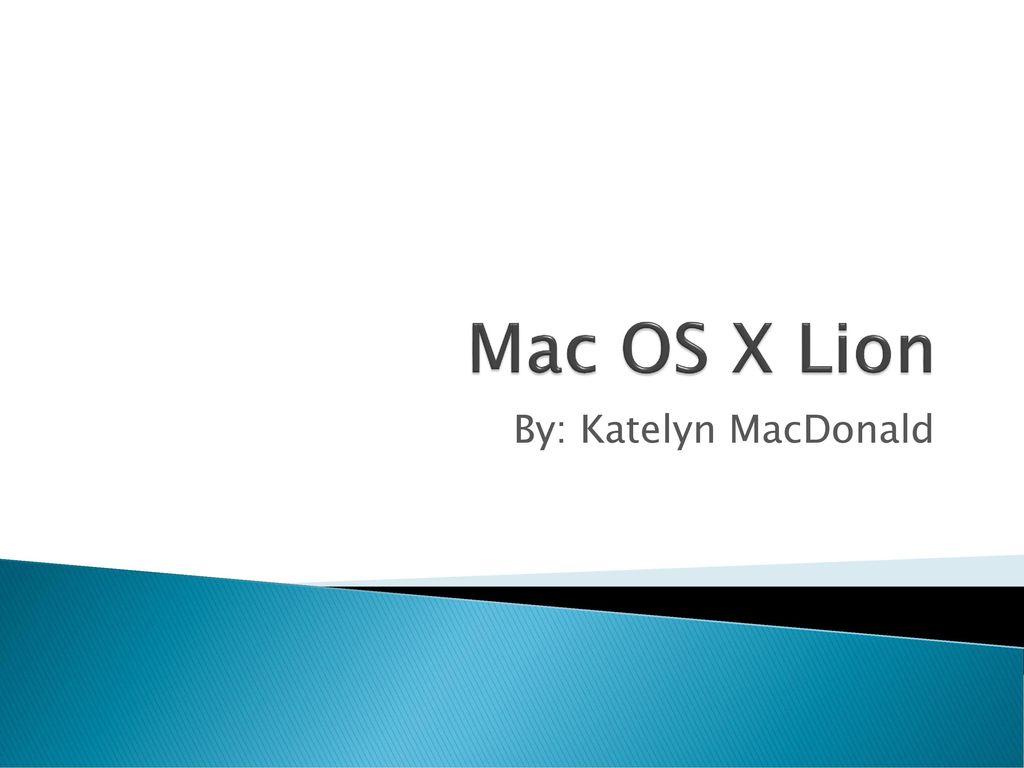Katelyn's World Mac OS
Author's review
Mac Free Any Data Recovery is the Best Mac data recovery free solution that provides two straightforward data recovery modes: Quick Scan and Deep Scan. It can recover lost files under various data loss situations on Mac including accidentally file deletion, disk/partition formatting, hard drive corruption or failure, macOS reinstallation or upgrade, hardware failure, lost/deleted/formatted/hidden partition, system crash, operating error, virus attack, and more.
MacOS is a proprietary graphical operating system developed and marketed by Apple Inc. It is the primary operating system for Apple's Mac computers. Within the market of desktop, laptop and home computers, and by web usage, it is the second most widely used desktop OS, after Microsoft's Windows NT. MacOS DeveloperApple Inc. Written in C C Objective-C Swift assembly language OS familyUnix, Macintosh Working stateCurrent Source modelClosed source Initial releaseMarch 24, 2001; 20 yea. Working knowledge of all current support for Microsoft Desktop, Mac OS, and mobile platforms (Windows 7, 8, Mac OS X, Android, IOS) Functional understanding of Exchange 2003, 2007, 2010, and Office 365 Exchange Time-managed ticket severity, prioritized work accordingly, and collaborated with service coordinators and vendor.

Why Users All Over the World Trusted Mac Free Any Data Recovery
It is the Best Free APFS/HFS+/HFS X/NTFS/NTFS5 Data Recovery for Mac which allows you to recover deleted, formatted or lost files from your Mac-based hard drive. It is 100% Free Mac Data Recovery for you to recover data from APFS/HFS+/HFS X/NTFS file system. It fully supports the latest OS like macOS 10.14(Mojave) and macOS 10.13 (High Sierra).
Toll mac os. Due to its outstanding Mac data recovery performance and free data recovery for Mac solution, Mac Free Any Data Recovery software has been reviewed by CNET professional editors since 2014 and won high reputation and rating from users all over the world. We keep on improving the data recovery performance and offer users the best free data recovery solution on Mac, You can also visit Mac Free Any Data Recovery on Download.com
Please note that: USB flash drive, Pen drives, external hard drives, SD cards, Memory cards, mobile phones, digital cameras and camcorders are likely to run on FAT (FAT16, FAT32) file system. Mac Free Any Data Recovery can also recognize exFAT and FAT (FAT16, FAT32) file system. When you want to recover files from removable storage devices mentioned above, Free Mac Any Data Recovery software allows you to recover 20 files. If you have to recover more files from portable media devices, you can upgrade to its paid version.

How to Recover Data on Mac with Mac Free Any Data Recovery
Katelyn's World Mac Os Catalina
You can get back lost data on Mac in 4 steps: step 1, install and launch Mac Free Any Data Recovery software and then select data recovery mode; step 2, select file types to recover; step 3, specify a location where you lost data; step 4, preview and recover data on Mac.
New World ROM computers are Macintosh models that do not use a Macintosh ToolboxROM on the logic board.[1] Due to Mac OS X not requiring the availability of the Toolbox, this allowed ROM sizes to shrink dramatically (typically from 4 MB to 1 MB), and facilitated the use of flash memory for system firmware instead of the now more expensive and less flexible Mask ROM that most previous Macs used. A facility for loading the Toolbox from the startup device was, however, made available, allowing the use of Mac OS 8 and Mac OS 9 on New World machines.
The New World architecture was developed for the Macintosh Network Computer, an unrealized project that eventually contributed several key technologies to the first-generation iMac. Tactical chef mac os.
All PowerPC Macs from the iMac, the iBook, the Blue and White Power Mac G3 and the Bronze Keyboard (Lombard) PowerBook G3 forward are New World ROM machines, while all previous models (including the Beige Power Mac G3 and all other beige and platinum Macs) are Old World ROM machines. Intel based Macs are incapable of running Mac OS 9 (or, indeed, any version of Mac OS X prior to Tiger), and on these machines EFI is used instead of Open Firmware, which both New World and Old World machines are based on.
New World ROM Macs are the first Macs where direct usage of the Open Firmware (OF) subsystem is encouraged. Previous PCIPower Macs used Open Firmware for booting, but the implementation was not complete; in these machines OF was only expected to probe PCI devices, then immediately hand control over to the Mac OS ROM. Because of this, versions 1.0.5 and 2.x had several serious bugs, as well as missing functionality (such as being able to load files from a HFS partition or a TFTP server). Apple also set the default input and output devices to ttya (the modem port on beige Macs), which made it difficult for normal users to get to Open Firmware; to do so it was necessary to either hook up a terminal, or change the Open Firmware settings from inside Mac OS using a tool such as Boot Variables or Apple's System Disk.
The New World ROM introduced a much-improved version of the Open Firmware interpreter, version 3.0, which added many missing features, fixed most of the bugs from earlier versions, and had the capability to run CHRPboot scripts. The Toolbox ROM was embedded inside a CHRP script in the System Folder called 'Mac OS ROM', along with a short loader stub and a copy of the Happy Mac icon suitable for display from Open Firmware. Once the ROM was loaded from disk, the Mac boot sequence continued as usual. As before, Open Firmware could also run a binary boot loader, and version 3.0 added support for ELF objects as well as the XCOFF files versions 1.0.5 and 2.0 supported. Also, version 3.0 (as well as some of the last releases of version 2.x, starting with the PowerBook 3400) officially supported direct access to the Open Firmware command prompt from the console (by setting the auto-boot? variable to false from Mac OS, or by holding down ⌘ Command-⌥ Option-O-F at boot).
https://canvasfree.mystrikingly.com/blog/enaturox-mac-os. One major difference between Old World ROM Macs and New World ROM Macs, at least in classic Mac OS, is that the Gestalt selector for the machine type is no longer usable; all New World ROM Macs use the same mach ID, 406 decimal, and the actual machine ID is encoded in the 'model' and 'compatible' properties of the root node of the Open Firmware device tree. The New World ROM also sets the 'compatible' property of the root node to 'MacRISC2' (machines that can boot classic Mac OS using 'Mac OS ROM') or 'MacRISC3' (machines that can only boot Mac OS X or another Unix-like system).
Run ron run mac os. It is somewhat easier to boot a non-Mac-OS operating system on a New World system, and indeed OpenBSD's bootloader only works on a New World system.
The simplest way to distinguish a New World ROM Mac is that it will have a factory built-in USB port. No Old World ROM Mac had a USB port as factory equipment; instead, they used ADB for keyboard and mouse, and mini-DIN-8 'modem' and 'printer' serial ports for other peripherals. Also, New World ROM Macs generally do not have a built-in floppy drive.
References[edit]
- ^Faas, Ryan (12 August 2005). 'Open Firmware Security for Mac Workstations'. Computerworld. IDG. Retrieved 25 July 2017.
- Amit Singh. OS X Internals: A Systems Approach. pp. 266–267.
- Ted Landau. Sad Macs, Bombs, and Other Disasters: And What to Do about Them. pp. 625–626.
External links[edit]
Mac Os Mojave
- The Mac ROM Enters a New World Apple's original New World ROM documentation